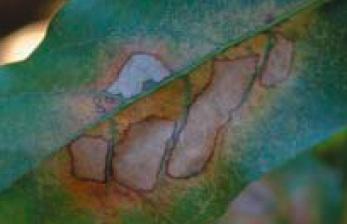Avocado leaf damage caused by avocado lace bugs
- Lace bugs restrict their feeding to the undersides of leaves, inserting their needle-like mouthparts into leaf tissue cells to extract cell contents.
- Feeding initially causes small white or yellow spots on the upper surface of the leaves as individual cells dry out.
- Feeding damage may provide entrance for pathogenic fungi such as leaf anthracnose fungi.
- As lace bug colonies grow, brown dead areas develop where there has been heavy feeding damage.
- Dead areas look similar to tip-burn caused by salt damage, but the necrotic areas are surrounded by living tissue.
- Heavy feeding can cause striking leaf discoloration and early leaf drop.
Avocado tree varieties vary in susceptibility to avocado lace bug
- West Indian x Guatemalan avocado hybrids appear to be particularly resistant to attack.
- Hass avocados (a Mexican-Guatemalan hybrid) can be severely damaged by lace bug outbreaks.
Biological control of avocado lace bugs
- The natural enemies attacking avocado lace bug in California are unknown, but are likely to include green lacewings and predatory thrips.
Chemical control of avocado lace bugs
- Pesticides used for controlling sucking insects may be effective against avocado lace bug.
Restrict movement of infested avocado foliage and wood
- Growers should refrain from moving avocado foliage and wood infested with avocado lace bugs.
